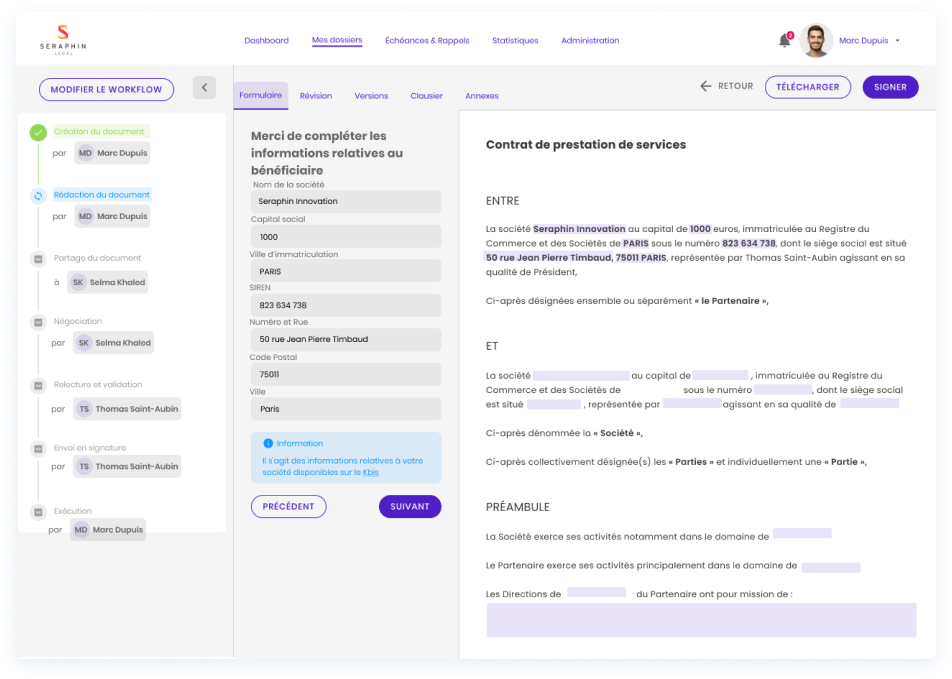Contract management and Covid-19 (Coronavirus): Contract Management actors are clear on this subject: contract risk management is the least successful process within their company despite the health crisis context. Efficient and intelligent management of your contracting cycle can enable you to react and face a crisis of the magnitude of the Covid-19 (Coronavirus) . What does this have to do with your contracting process? A company's ability to conduct its business in times of crisis is based on informed decisions, and your contracts are the data that drive those decisions.
It is essential for a company to ask itself the following question: do we have enough information about our contracts to maintain the confidence of our contracting parties or to protect our structure from emerging risks?
We provide you with 3 levers that will allow you to answer this question.
Automation: a financial lever to reduce your costs
The early stages of the contracting cycle, from drafting to signing, are a cost centre.
Manually managed, these steps can slow down your negotiations and increase your cost per contract.
Details of the costs of producing a contract according to World Commerce & Contracting
The Cost of a contract, Tim Cummins, President of WCC
| Resources | Time in hours | Cost (in $) |
| Legal expertise | 2.5 | 500 |
| Contract Management | 18 | 2700 |
| Finance | 2 | 300 |
| Compliance, risk management | 6 | 1000 |
| Other resources | 600 |
According to theEuropean School of Contract Management survey, 79% of contract managers still use an office suite. Yet 83% of the teams involved in contract management say they are dissatisfied with their contract process. It's no secret: Word alone is not enough to manage your contracts.
Today, contract management software automates a large part of the contracting process (up to 90%) and allows you to reduce the cost of your contracts by a third.
In addition to reducing costs, opting for automation in the management of your contracts also reduces risks: the document is secure, your clauses and wording are protected, only the designated fields are modified by the completion of the form.
Good practice 💡:
These practical sheets will enable you to automate the following contracts: |
Centralisation: a strategic information lever
According to a report by the Contract Management Journal, 71% of companies fail to locate at least 10% of their contracts. A company that does not control its contractual assets can jeopardise its business, even more so in times of crisis. Centralization is therefore a particularly important game for your action plan "Contract Management vs Covid-19.
Controlling the legal risk of contracts in progress requires easy access to them.
By centralising your contractual assets, you ensure the legal security of your contracts while collecting essential information on your business and contractual performance.
Among the many benefits of contract management software : create your contract library and archiving your contracts centrally, search for a given piece of information via an integrated search engine. Updates following legislative changes will no longer be a huge task: you can find the clauses concerned in a few clicks and make the changes.
Centralisation allows data to be fed back into the system as a strategic information lever.
From a financial point of view, the centralisation of contractual data allows you to rigorously monitor your commitments: for example, to track discounts and rebates, to ensure the conformity of invoiced items or to have a global view of contracts already negotiated at the company level.
Good to know 💡: Centralising information also allows you to track the cost of ownership of your contracts throughout their lifecycle by taking into account direct, indirect costs and risk factors.
Good practice 💡 :
|
Data: a lever of influence to determine your next actions
Your contractual data can enable you to manage your activity thanks to reliable indicators and carry out different types of projects.
- Justifying a recruitment
- Optimising an internal process
- Justify the investment in a new tool
- Highlighting the performance of a contract or team member
The aim is to leave no room for interpretation, either with your team or with the people to whom you report. No more "I think that", "I have the impression that", your key indicators will henceforth be your authoritative arguments for your proposals and decision making.
Moreover, this data also allows you to reveal malfunctions and adopt the necessary action plan to resolve them.
All of these best practices are key to choosing your contract management solution. They have enabled the most efficient companies to reduce the costs associated with their contracts and to reduce the contractual risks faced by their organisations.
Choose to combine contractual performance and legal certainty
No commitment, no credit card.




